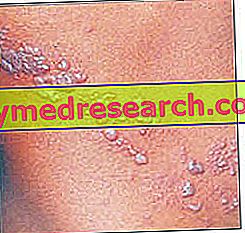Generality
Post-herpetic neuralgia is the most frequent complication of shingles or shingles, a viral disease characterized by the appearance of vesicular skin eruptions, accompanied by intense, continuous and burning pain; these typical eruptions (see image) appear in the distribution areas of the spinal roots affected by the Herpes Zoster virus, also known as Varicella Zoster.
In some cases the pain that accompanies and characterizes St. Anthony's fire, rather than resolving spontaneously, persists for an unpredictable period; in these cases we speak of Post Herpetic Neuralgia (NPH).
Definition
Post-herpetic neuralgia is defined as a pain that continues or recurs at the site of a previous herpes zoster within three months of the rash;

Inevitably, this heterogeneity in definitions creates many difficulties in the interpretation of epidemiological and therapeutic data.
Epidemiology and risk factors
The risk of developing post-herpetic neuralgia increases with age, affecting especially people over 50 years of age. Below this threshold the incidence of post-herpetic neuralgia is less than 20%, while it increases progressively after 60 years, accompanied by a reduction in the probability of spontaneous resolution. It is estimated, for example, that post-herpetic neuralgia affects 27, 47 and 77% of untreated adults aged 55, 60 and 70, respectively. It should be noted, in this regard, the discordant epidemiological data present in the literature, heavily influenced by the criteria used in defining and identifying post-herpetic neuralgia.
Symptoms
In the worst case scenario, the pain that characterizes post-herpetic neuralgia is continuous, superficial, burning (burning) and typically located in a very precise and hypersensitive area; the pain is often exacerbated violently by contacts, even slight, of the injured area, therefore perceived in an explosive manner for a period longer than normal; for example, simple contact with clothes, nocturnal movements or even sudden changes in temperature, sudden noises or emotional stress can trigger violent and excruciating pain that can seriously compromise quality of life.
The intensity of the pain is in any case variable and highly subjective, so the symptomatology can occur even in a much milder manner and be limited to a slight itching with a feeling of numbness.
Post-herpetic neuralgia can remain long (months or even years) after healing of skin lesions.
Care and Therapy
The therapies proposed for the treatment and treatment of post-herpetic neuralgia are very numerous, but opposed - in general - to a poor effectiveness. It follows that the need to carry out adequate prevention is still primary, resorting to a pharmacological prophylaxis with antivirals to start as early as possible: this treatment must be undertaken no later than 72 hours after the first prodromal manifestation (skin rash), and should be continued for 7-10 days (disappearance of symptoms). These drugs also help mitigate the pain in the acute phase of the disease and accelerate healing, and can be associated with corticosteroids (prednisolone) and amitriptyline. For patients over the age of 60, vaccination may be advisable.
In case post-herpetic neuralgia is already manifest, a combination of useful treatments to reduce pain is generally used:
- Topical treatments : application of gel, or even better, patches, based on 5% Lidocaine in the affected area. In most cases this treatment offers temporary relief from pain. The topical applications of capsaicin ointments 0.025-0.075% or aspirin in diethyl ether are less effective but potentially useful.
- Systemic treatments : the treatment of choice is represented by tricyclic antidepressants (desipramine, amitriptyline, nortriptyline, maprotiline), to be taken in small evening doses to be increased during therapy according to medical indications. Painkillers such as paracetamol and opioid oxycodone and tramadol are also potentially useful. Some drugs used in the treatment of epilepsy ( anticonvulsants or antiepileptics, such as gabapentin or pregabalin) can reduce the pain associated with postherpetic neuralgia.
- Vaccination : Zostavax is indicated for the vaccination of subjects aged 60 or over to prevent herpes zoster and associated herpetic neuralgia. According to a recent study, this vaccine helps to halve the risk of developing Post Herpetic Neuralgia compared to unvaccinated subjects.
Drugs for the treatment of Post Herpetic Neuralgia »



